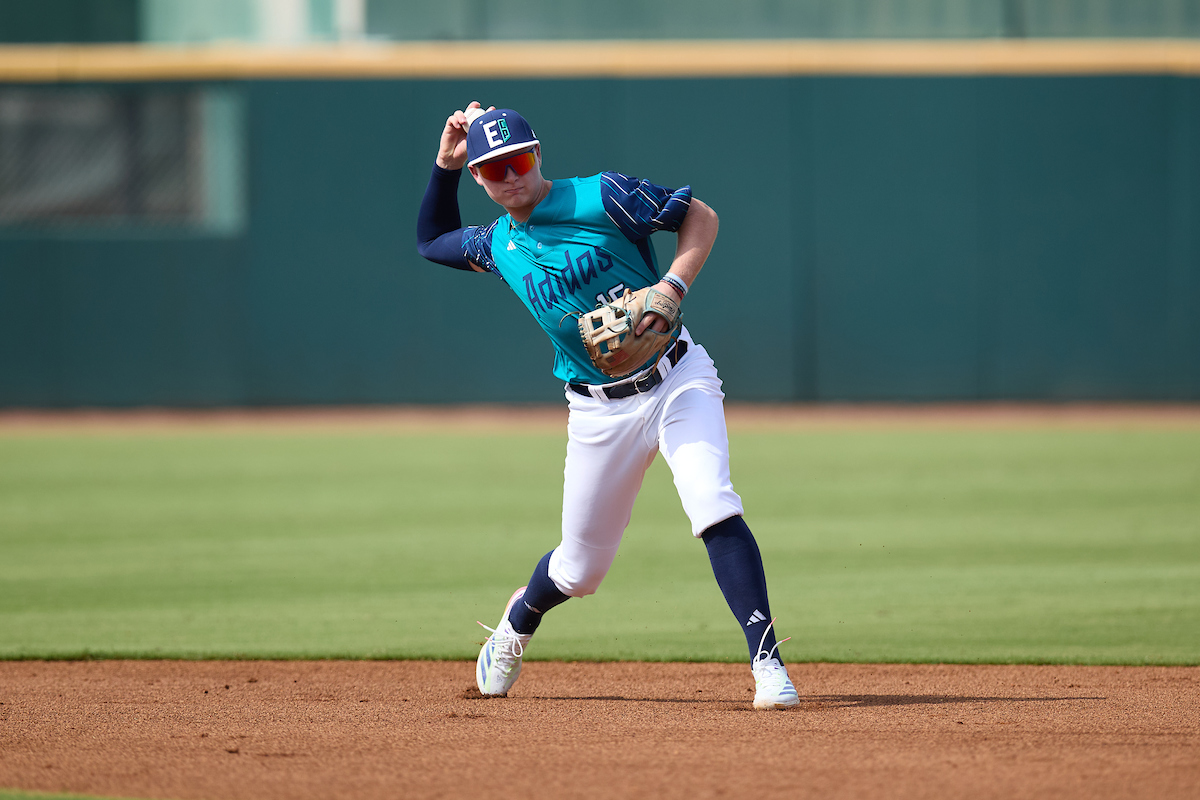Since Valentine’s Day, we have covered a lot of ground with our 2025 MLB draft coverage on Sox Machine. A lot of what was written concerned the progress college prospects were making, or, in the case of college hitters, not making. We checked in with the NHSI tournament where Seth Hernandez shined and we got to see how Billy Carlson handles better prep pitching.
The summer showcase data was helpful, but it was nice to get refreshed data from prep players at the MLB Draft Combine. At this stage, scouting is mostly complete, except for re-watching film of specific prospects. Now is the time for front office personnel to negotiate with agents and work out signing bonuses.
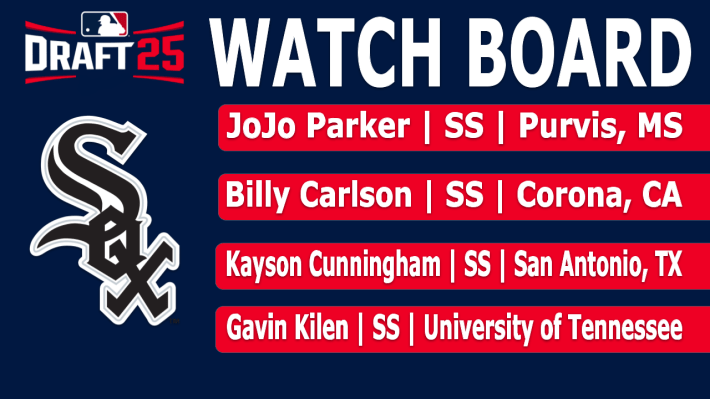
Speaking with Scott Merkin while the White Sox were in Denver, scouting director Mike Shirley tried not to reveal his hand, but offered fans a glimpse into what the team had in mind with their first pick. Chris Getz followed that up earlier this homestand when explaining the difficulty in acquiring top prospect talent through trades and how the draft is a great way to shore up that organizational weakness.
I’ll make a final guess on what the White Sox could do in my final mock draft this weekend, but let’s zoom out a bit on the draft radar so we are not caught off guard (like we were with Noah Schultz in 2022) and introduce new prospects to the conversation.
First Round Targets (Pick 10)
Shirley told MLB.com the White Sox are currently considering at Pick 10:
- One high school pitcher
- Five high school shortstops
- Two college hitters
- Two college pitchers
High School Pitcher
RHP Seth Hernandez, Corona High School
Seth Hernandez has one of the highest upsides of any prospect in this draft class. As a teenager, Hernandez has a plus fastball that can reach 100 mph and a 60-grade changeup. Further refinement and development will be needed to improve Hernandez’s breaking pitches, but the talent is real. I don’t think it’s the lack of stuff that is hurting Hernandez’s draft stock as much as recent draft trends with prep pitchers.
The last prep pitcher taken in the first round to accumulate more than 10 WAR per Baseball-Reference.com is Cincinnati Reds starter Hunter Greene. Nobody doubted the talent, and Greene was an All-Star in 2024 when he went 9-5 with a 2.75 ERA and was worth 6.2 bWAR, but he hasn’t pitched more than 150 innings a season due to injuries. As of this writing, Greene last appeared in a game on June 3, 2025.
Jackson Jobe, who reached the majors this season with Detroit, will miss the rest of 2025 due to Tommy John surgery after making 12 appearances. Chase Petty was rocked in three appearances, allowing 14 runs in six innings, and Mick Abel is off to a rocky start to his major league career. Those three are the most recent prep pitchers selected in the first round to make the majors.
Developing teenage pitchers is hard. With the amount of money going into development labs and new baseball facilities, top college programs arguably do a better job of development with pitchers under age 20 than major league clubs. No matter how talented Hernandez is, some major league clubs will pause before investing a top-10 pick in him.
High School Shortstops
JoJo Parker, Purvis High School
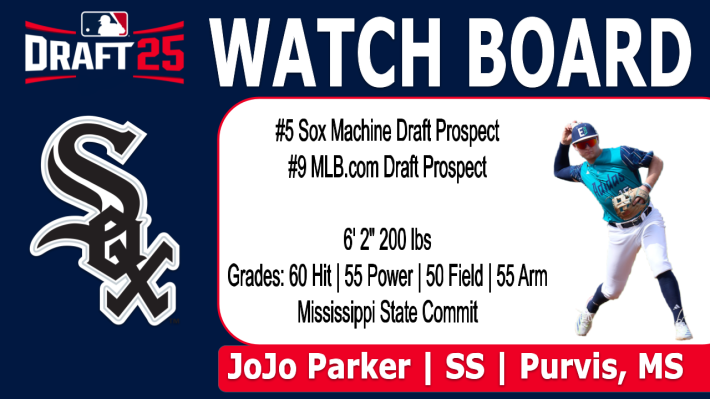
The highest riser on draft boards this season is prep shortstop JoJo Parker from Mississippi. It's reminiscent of last year, when there were many doubts surrounding top Mississippi prep player Konnor Griffin. Those doubts appear to be unwarranted.In 74 games spanning A and A+ ball, Griffin is hitting .330/.402/.527 with 13 home runs, and The Athletic’s Keith Law was impressed with how well Griffin is handling the shortstop position. It appears that concerns about low-quality prep competition haven’t impacted Griffin, and those worries are not being brought up when people discuss Parker now.
Watching the MLB Draft Combine film, Parker is not lighting up leaderboards with max exit velocities, but he’s consistently barreling up the ball. The swing appears to be low-impact, and Parker demonstrates good body control through rotation. I haven’t seen him overswing, and other scouting reports are high on his contact ability. As Parker gets older and stronger, his profile could be 60-grade contact / 50-grade power. The question is whether Parker can stick at shortstop, but as Griffin is proving with the Pirates, being patient with the defense can pay off.
Eli Willits, Fort Cobb-Broxton High School
Just 17 years old on draft day, Eli Willits receives high praise for his competitiveness and overall skill set. There’s little doubt that Willits has the athleticism to stick at shortstop as he’s demonstrated good range and throwing strength at showcases (91 mph at Perfect Game showcase last July). Initially slated for the 2026 draft, Willits reclassified to take advantage of a poor college position player class.
For the data-driven amateur scouting departments, I wouldn’t be surprised if Willits is at the top of their draft boards. A team can remain patient in developing Willits at each minor league level, and he would still be 21 years old when he reaches the majors. One concern is how much power Willits will be able to generate, but there are enough plus skills with contact and defense that he should project to be an above-average major leaguer.
Billy Carlson, Corona High School
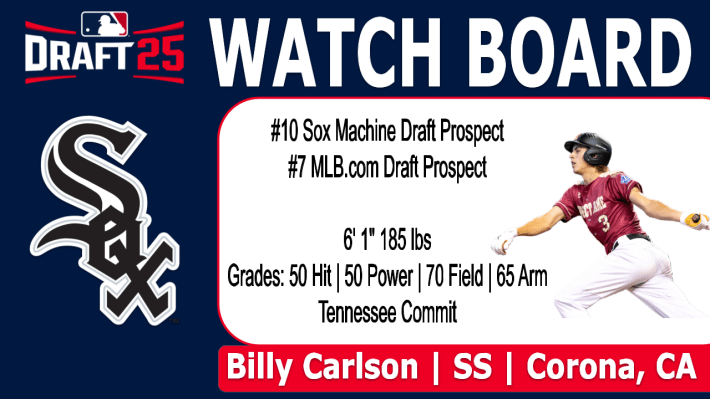
While age modeling works in Eli Willits' favor, it's used against Billy Carlson, who will be turning 19 years old on July 29. For White Sox fans, Colson Montgomery was 19 years old when taken in the first round in 2021. If you are searching for a more optimistic case study, consider Bobby Witt Jr., who was 19 shortly after the Royals drafted him second overall in 2019.
Carlson is by far the best defensive shortstop in this draft class. He possesses exceptional footwork and range, and he pairs that level of athleticism with a cannon of a throwing arm, hitting 99 mph during infield drills during last year's Perfect Game showcase. On the 2025 MLB Draft Preview podcast, Jim Callis shared that some scouts give Carlson a 70 grade defensively. That's wild for a prep shortstop, but Carlson looks the part.
The reason why Carlson is not going first overall is that the swing needs work. In the video capture below from this spring's NHSI tournament, Carlson stands upright but implements a leg kick as the pitcher starts their motion.
As the knee lifts, Carlson rotates his front hip in and proceeds to lunge at the pitch. His hands drag through the zone, oftentimes his bat is wrapped behind his head, and Carlson doesn't catch the pitch out in front of home plate consistently. A lot of the game action from NHSI showed Carlson looking for pitches on the outer half to swing at, which raises questions about his current ability to pull the ball.
These attributes make Carlson a project at the plate, which some teams may shy away from with a top-10 pick. But he has the makings to be an elite defender, and if a team believes in its ability to help young players optimize their swings, there's a Dansby Swanson-level ceiling for Carlson.
Kayson Cunningham, Johnson High School

At 5-foot-10, Kayson is a bit undersized at shortstop, but flashed the leather during the MLB Draft Combine to quiet concerns about his defense. Long-term, Cunningham might be a second baseman, which dims his prospect profile. Just like Carlson, Cunningham is on the older side for prep players turning 19 years old on June 25.
A left-handed bat, Cunningham excelled last year for the U-18 Team USA squad, hitting .417/.483/.542 with three doubles in 24 at-bats the previous summer (Ethan Holliday was 3-for-22). During the Draft Combine hitting drills, Cunningham had an average exit velocity of 94.9 MPH and a max of 107.2 MPH. The longest home run Cunningham hit went 420 feet. Offensively, there’s a lot to be excited about with Cunningham’s profile, even if he does end up at second base.
Steele Hall, Hewitt-Trussville High School
One of the fastest players in this draft class, Steele Hall is another reclassified prospect from the 2026 pool, and he turns 18 in two weeks. Hall received 70 grades for his speed, and that level of athleticism gives teams hope that he can handle shortstop or center field in the future. Hall didn't participate in the MLB Draft Combine's hitting drills, and there isn't a lot of data from the prep showcases to judge his power potential accurately. While I am confident about what Billy Carlson can offer, there isn't a great deal of video or data to go on regarding Hall. It makes him a mystery, but the scouting reports continue to rave about Hall's potential.
College Hitters
Gavin Kilen, University of Tennessee
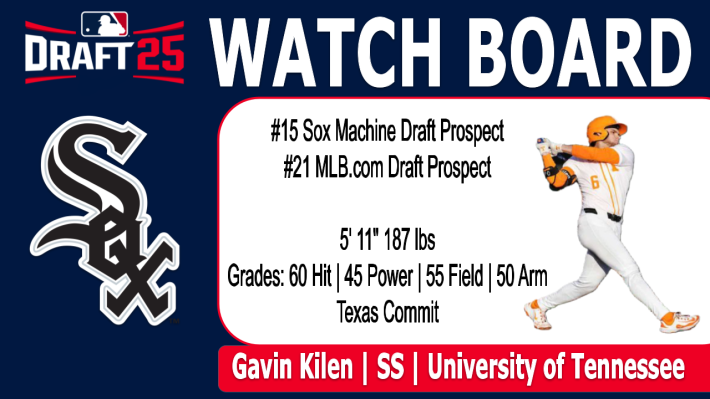
Hailing from Milton, Wisc., and a former member of their Area Code team, Gavin Kilen checks a lot of the boxes in a position player the current White Sox front office is seeking. He struck out just 9.7 percent of the time over 150 games between Louisville and Tennessee. However, there are some questions about how Kilen reworked his approach at Tennessee, as in 402 plate appearances with Louisville in 2023 and 2024, Kilen walked only 17 times. That’s an eye-opening lack of walks, but Kilen increased that amount to 30 with Tennessee in 2025, holding a 12.2 percent BB rate.
What kind of plate discipline Kilen will show professionally remains to be seen. Still, he’s demonstrated excellent contact skills the last two seasons with a noticeable increase in power. While Kilen started the season at second base, Tennessee eventually moved him to shortstop as the Vols dealt with defensive shortcomings in the second half of 2025. At this point, I consider Kilen a fringe major league shortstop and more likely an everyday second baseman. According to D1Baseball.com, Kilen’s max exit velocity in 2025 was 110.3 MPH, and his in-zone contact rate was 88.6 percent.
Marek Houston, Wake Forest University
Marek Houston had a fast start in 2025 but experienced a six-week lull that raised questions about his hitting potential. There’s no doubt that Houston has the attributes to stick at shortstop professionally. He has excellent range, especially moving to his left, and is an accurate thrower no matter the angle. But the power potential is limited with Houston, who only hit five home runs away from Wake Forest in 2025. At the Cape Cod League last summer, Houston did hit .306 in 114 plate appearances but only slugged .329 (two doubles, no home runs). It might be a 40-grade or below power profile unless Houston makes adjustments to tap more slugging potential from his swing.
College Pitchers
Kyson Witherspoon, University of Oklahoma
Kyson Witherspoon had only one bad start in 2025, but it came at an unfortunate time in Regionals against North Carolina, where he got tagged for nine runs (only three earned) off 10 hits in four innings of work. Outside of that performance, Witherspoon demonstrated that he’s the best right-handed college starter in this draft class. Against Minnesota earlier this season, Witherspoon flashed three plus pitches with a four-seam fastball, cutter, and sinker. As a professional, Witherspoon might be better off focusing on the sinker and cutter mix as it tunnels better than his four-seam and slider offerings.
In 16 starts, Witherspoon pitched 95 innings with a 2.65 ERA and a 3.89 FIP. He struck out 31.8 percent of the batters he faced while only walking 5.9 percent.
Tyler Bremner, UC-Santa Barbara
Ranked No. 3 on the Sox Machine Preseason 2025 Draft Rankings, Tyler Bremner had a terrible first two months of 2025, making me question what the hype was about. However, Bremner saved his best for the last two outings of the season, combining over 13.1 innings to allow only one run on four hits while striking out 23 of 45 batters faced.
When Bremner is right, it’s a mid-90s fastball paired with an excellent changeup that generates a lot of whiffs in the strike zone. In some ways, Bremner reminds me of Lucas Giolito, but there were scouting reports from the USA College National Team last summer that referenced elite-breaking stuff. I didn’t see that much breaking stuff in 2025, but if Bremner can develop a plus third offering, he could make many teams regret not taking him earlier in the first round.
Second Round Targets (Pick 44)
"If you can get 2-for-1, that's always the goal," Shirley told reporters Thursday. If that holds, expect a significant over-slot bonus signing from the White Sox with the 44th pick. Last year, the White Sox paid Caleb Bonemer $2,997,500 at No.43, and that $3 million amount could be another targeted budget. That bonus amount is almost equal to the 31st slot value. For any team, paying that much over slot is certainly intended to buy out a prep player’s college commitment. Below are possible prep targets for the White Sox starting in the second round.
RHP Matthew Fisher, Evansville Memorial High School
An Indiana commit, Matthew Fisher showed a four-pitch mix during the prep season, going with a four-seamer, curveball, slider, and changeup. The velocity has reportedly been inconsistent, with Fisher topping out in the low 90s MPH on some outings but reaching 95 MPH on others. Fisher gets credit for impressive spin rates above 2700 RPMs from Prep Baseball Report. In the Sox Machine Top 100 Draft Rankings, Fisher ranks as the second-best prep right-hander in this class.
LHP Jack Bauer, Lincoln-Way East High School
A left-handed pitcher who hits 102 MPH on the radar gun. What more do you want?
Committed to Mississippi State, Jack Bauer has caught a lot of the industry’s attention with the heat. There are obvious questions about a young pitcher throwing that hard, like “When are the elbow ligaments going to snap?” Bauer has a three-quarter delivery that he pairs with a slider that spins RPMs between 2500 and 2700 at mid-80s velocity. It’s a pitching project, but there are not that many southpaws who throw this level of velocity.
OF Jacob Parker, Purvis High School
The brother of JoJo, Jacob Parker flashed impressive batted-ball data from showcases and the MLB Draft Combine. During batting drills at the combine, Parker averaged 101.1 mph exit velocity with a max of 110.1 mph. A left-handed hitting outfielder is right up the White Sox alley in terms of desired prospects, but Jacob is not as polished as JoJo. While he puts on a show during batting practice, there’s skepticism about the ability to produce these exit velocities in-game, as the swing is a bit long. However, if there’s a chance to negotiate a 2-for-1 package that nets the Parker Brothers, it might be worth it for many MLB teams that can afford it.
OF Jaden Fauske, Nazareth Academy
Current gossip around circles is that local kid Jaden Fauske will be off the board when it’s the White Sox turn at pick 44. However, if things change, Fauske is a left-handed bat who was part of the White Sox Area Code team and is committed to LSU. From Prep Baseball Report events, Fauske posted a max exit velocity of 104.7 MPH and an average of 97.6 MPH. He isn't a great runner (7.13 seconds in the 60-yard dash), but he moved from catcher to the outfield during his time at high school.
C Taitn Gray, Dallas Center-Grimes High School
Two prospects shocked me with their power potential during the MLB Draft Combine: Quentin Young, who is projected to be a late first-rounder, and Taitn Gray. I knew a bit about Young, as he was another reclassified prospect and the nephew of former major leaguers Delmon and Dimitri Young. At 6-foot-6 and built like a defensive end, it’s hard to miss Young.
But it was Gray who captured my curiosity and led me to find as much film as possible. Posting an average exit velocity of 102 mph and a max of 114.5, Gray hit one deep fly that had a projected distance of 434 feet. Those readings are consistent with what Gray put up at Prep Baseball Report’s Super 60 event this past February (109.2 mph max, 102.9 average).
Admittedly, I had to use Google Maps to find where Grimes, Iowa is (it’s a suburb of Des Moines), but the more I saw from Gray, the more he seemed like a White Sox target. A switch-hitter that produces this level of power is what the White Sox need more of in their system. Gray was a catcher in high school, but with a 6.64 60-yard dash time, it might be worthwhile to see what he could do in the outfield. An Oregon commit, Gray is a prospect that’s flying a bit under the radar with limited appearances in showcase and national tournaments.
